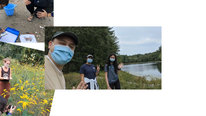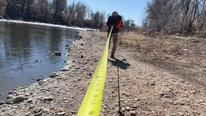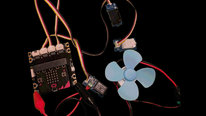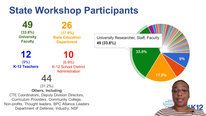- Yasmin Kafai
- http://scholar.gse.upenn.edu/kafai
- Lori and Michael Milken President’s Distinguished Professor
- Presenter’s NSFRESOURCECENTERS
- University of Pennsylvania
- Deborah Fields
- https://itls.usu.edu/people/faculty/fields/
- Associate Research Professor
- Presenter’s NSFRESOURCECENTERS
- Utah State University
- Tyler Hansen
- Master's Student
- Presenter’s NSFRESOURCECENTERS
- Utah State University
- Amanda Strawhacker
- http://amandastrawhacker.com
- Associate Director, Early Childhood Technology (ECT) Graduate Certificate Program
- Presenter’s NSFRESOURCECENTERS
- Tufts University
- Jen Sun
- https://www.linkedin.com/in/jen-sun-22887a6/
- President
- Presenter’s NSFRESOURCECENTERS
- Numedeon Inc.
- Colby Tofel-Grehl
- Associate Professor
- Presenter’s NSFRESOURCECENTERS
- Utah State University
RAPID: Virtual Epidemics for Promoting Upper Elementary and Middle School Stu...
NSF Awards: 2031748
2021 (see original presentation & discussion)
Grades 6-8, Grades 9-12
Learning about infectious disease has never been so relevant to education. Virtual epidemics are an innovative, promising approach to allow people to experience an epidemic safely while giving them agency to study and take action against it. In 2020, in response to the COVID-19 pandemic, our team of researchers, educators, and designers created the SPIKEY-20 virtual virus in the virtual world of Whyville.net to provide an opportunity for people around the country to playfully and safely experience, investigate, and fight against the virtual disease. SPIKEY-20 mirrors the respiratory disease of COVID-19 with its asymptomatic yet infectious period, and includes visual and conversational symptoms as well as economic costs intended to draw the attention of players. The virus was released in two phases, once in Fall 2020 and with a more infectious variant in Winter 2021 and included an accompanying suite of personal protective equipment, unlimited virus testing (albeit with false negatives and positives) and a two-stage vaccine during the second wave of infections. Research on online and in-class participation demonstrated active engagement with the virus, including: repeated testing, improved usage and choice of PPE, and reflective comparisons between players’ SPIKEY-20 and COVID-19 experiences. For more info, see http://epidemic.whyville.net
Related Content for SPIKEY-20: A Virtual Epidemic for Connecting with COVID-19
-
 2021COVID-Inspired Data Science for Youth
2021COVID-Inspired Data Science for Youth
Jan Mokros
-
 2021TUSKEGEE UNIVERSITY COVID19 AWARE PROGRAM
2021TUSKEGEE UNIVERSITY COVID19 AWARE PROGRAM
Crystal James
-
 2021Lessons Learned by STEM Master Teachers from the Pandemic
2021Lessons Learned by STEM Master Teachers from the Pandemic
Raffaella Borasi
-
 2021Responding to an Emerging Epidemic through Science Education
2021Responding to an Emerging Epidemic through Science Education
Troy Sadler
-
 2021Effects of COVID-19 on Undergraduate Education
2021Effects of COVID-19 on Undergraduate Education
Chelsea LeNoble
-
 2021STEM Up NY: Clarkson University Noyce Scholars Program
2021STEM Up NY: Clarkson University Noyce Scholars Program
Seema Rivera
-
 2021Parents listen in: STEM at home with children during COVID
2021Parents listen in: STEM at home with children during COVID
Caitlin Martin
-
 2021Dancing in STEM: Social Media Trends to Bring STEM to All
2021Dancing in STEM: Social Media Trends to Bring STEM to All
Heather Masson-Forsythe
Playlist: ITEST Videos Playlist
-
 2021Socially-Distanced Community Conservation Partnerships
2021Socially-Distanced Community Conservation Partnerships
Nicole Freidenfelds
-
 2021CryptoComics - Cryptology and Cybersecurity for Kids
2021CryptoComics - Cryptology and Cybersecurity for Kids
Christine Wusylko
-
 2021Stories of Algebra for the Workplace
2021Stories of Algebra for the Workplace
Candace Walkington
-
 2021Empowering Students in Math Through Entrepreneurship
2021Empowering Students in Math Through Entrepreneurship
Erin Krupa
-
 2021Inventing Designing and Engineering for All Students
2021Inventing Designing and Engineering for All Students
Wendy Martin
-
 2021The Human Body in P6 STEM Teaching: The BODYMODELS Project
2021The Human Body in P6 STEM Teaching: The BODYMODELS Project
Neal Grandgenett
-
 2021Our Experiences with Game Based CRC, Esports, and the Future
2021Our Experiences with Game Based CRC, Esports, and the Future
Mark Van Auken
-
 2021iSTEM-Xe: Implications of COVID-19 on the Black Community
2021iSTEM-Xe: Implications of COVID-19 on the Black Community
Shannon Jolly
-
 2021Interest Stereotypes Cause Gender Gaps in STEM Motivation
2021Interest Stereotypes Cause Gender Gaps in STEM Motivation
Marley Jarvis
-
 2021Voices to Hear
2021Voices to Hear
Shakuntala Gopal
-
 2021Challenger Center Classroom Adventures
2021Challenger Center Classroom Adventures
Lance Bush
-
 2021Chief Science Officers Go Virtual
2021Chief Science Officers Go Virtual
Kelly Greene
-
 2021Billion Oyster Project Curriculum and Community Enterprise
2021Billion Oyster Project Curriculum and Community Enterprise
Dr. Lauren Birney
-
 2021Catalyzing Inclusive STEM Experiences: Tune in for Equity
2021Catalyzing Inclusive STEM Experiences: Tune in for Equity
Lara Hebert
-
 2021Super Fun Science of Music Hands-on Online Tools.
2021Super Fun Science of Music Hands-on Online Tools.
Victor Minces
-
 2021Impact of a Family-Community-University Engineering Project
2021Impact of a Family-Community-University Engineering Project
Amber Simpson
-
 2021SPIKEY-20: A Virtual Epidemic for Connecting with COVID-19
2021SPIKEY-20: A Virtual Epidemic for Connecting with COVID-19
Yasmin Kafai
-
 2021GaleForce: Girls Immersed in Robotics Learning Simulations
2021GaleForce: Girls Immersed in Robotics Learning Simulations
Beryl Hoffman
-
 2021My STEM Story: Students Explore Science Identities
2021My STEM Story: Students Explore Science Identities
Ed Madison
-
 2021COVID-Inspired Data Science for Youth
2021COVID-Inspired Data Science for Youth
Jan Mokros
-
 2021Engineering Design for Rural Middle School Students
2021Engineering Design for Rural Middle School Students
LaTricia Townsend
-
 2021SEBA: STEM Engagement Through Mentoring
2021SEBA: STEM Engagement Through Mentoring
Rick Greer
-
 2021Engineering WINS
2021Engineering WINS
Jacqueline Genovesi
-
 2021Developing Middle School Students' AI Literacy
2021Developing Middle School Students' AI Literacy
Helen Zhang
-
 2021Collaboration Dynamics and Culturally Responsive Teaching
2021Collaboration Dynamics and Culturally Responsive Teaching
Meredith Kier
-
 2021Sustaining a STEM Learning Ecosystem During a Pandemic
2021Sustaining a STEM Learning Ecosystem During a Pandemic
Denise Nacu
-
 2021Internships for Underrepresented Students Amid the Pandemic
2021Internships for Underrepresented Students Amid the Pandemic
Lynda Gayden
-
 2021Place-Based Data Literacy: Protecting the Platte
2021Place-Based Data Literacy: Protecting the Platte
Samantha Schall
-
 2021Embodied Coding in Augmented and Virtual Reality
2021Embodied Coding in Augmented and Virtual Reality
Ying Wu
-
 2021WeatherBlur: student initiated citizen science program
2021WeatherBlur: student initiated citizen science program
Rebecca Clark Uchenna
-
 2021Enabling Opportunity: Bridging Science & Physical Computing
2021Enabling Opportunity: Bridging Science & Physical Computing
David Jackson
-
 2021Helping States Plan to Teach AI in K-12
2021Helping States Plan to Teach AI in K-12
Christina Gardner-McCune
-
 2021RPPforCS: Research Practitioner Partnerships across K-12
2021RPPforCS: Research Practitioner Partnerships across K-12
Rebecca Zarch
-
 2021Keeping the focus on dimensions of quality math discourse
2021Keeping the focus on dimensions of quality math discourse
Paola Sztajn
-
 2021Building Community to Shape Emerging Technologies
2021Building Community to Shape Emerging Technologies
Judi Fusco






Troy Sadler
This is a fascinating approach to teaching about the pandemic. What challenges did you encounter/design for in attempting to replicate and represent COVID-19?
Yasmin Kafai
Rosio Bugarin Pedroso
Colby Tofel-Grehl
Yasmin Kafai
Lori and Michael Milken President’s Distinguished Professor
We had multiple challenges, most of them related that a virtual world can be an ideal case, especially compared to the real world. for one there is no death. We did this because we wanted this to be a less agonizing experience especially since many students might have COVID illnesses and even death in families. Then of course, we had abundance of free testing, which is not available in the real world yet (one wonders why?).
Justice Walker
Kirstin Milks
Rosio Bugarin Pedroso
Colby Tofel-Grehl
Associate Professor
I think the unexpected challenge we encountered was managing teacher burn out and engaging classrooms that are standards based. One of the things that I think COVID-19 laid bare was how absent some science concepts and skills are from the NGSS. In so many ways the NGSS are amazing and do an incredible job organizing and systematizing scientific learning on a large scale. However, disease spread and the associated agency of individuals to combat that is fairly absent. As researchers looking at the standards from the 10,000 foot perspective we tend to see connections and tie ins that are possible. Classroom teachers, however, feel highly constrained in what they can cover in a standards based world.
Jacob Sagrans
Sarah Haavind
Kirstin Milks
Yasmin Kafai
Rosio Bugarin Pedroso
Pendred Noyce
Colby, your point about the absence of some concepts and skills from the NGSS is important. The NGSS does not mention viruses, vaccines, epidemics, the WHO or the CDC--and unfortunately, as a result, many classroom teachers, even in this crazy year, feel unsupported when they want to teach about what's happening right now in the real worls. Did you work primarily in classrooms, or also in afterschool environments? About how much time class time did Whyville take? And is this something a child could do at home, or does it need teacher scaffolding?
Yasmin Kafai
Colby Tofel-Grehl
Associate Professor
Our project focused on classrooms. We designed and implemented a classroom curriculum but even with the standards alignment explicated for them, the teachers were anxious. The curriculum was ten periods long. We did have home school kids doing it as well so it was accessible to everyone:)
Kirstin Milks
Yasmin Kafai
Yasmin Kafai
Lori and Michael Milken President’s Distinguished Professor
You can find more info about the curriculum here: http://www.whyville.net/smmk/swoop/flyer2020 plus a link to all of the activities.
Justice Walker
Yasmin Kafai
Yasmin Kafai
Lori and Michael Milken President’s Distinguished Professor
Thank you for taking the time to watch our video on a virtual epidemic to help people playfully learn about pandemics. Our team of educators, designers, and researchers would be interested in your feedback especially in regard to the following questions:
- How could you see using this virtual epidemic in your classes or homes?
- Where do you see this connecting to classrooms (subjects, standards, etc.)?
- What parts of the virtual epidemic seem more interesting/helpful to you? What do you want more information about?
- Is there anything else you'd be interested in seeing in the design of a virtual epidemic?
Deborah Fields
Rosio Bugarin Pedroso
Joan Freese
I'm impressed that you were able to make this work happen so quickly during COVID. Did you have the concept prior to COVID? In other words, was is an idea you'd been noodling or was this work in response to the epidemic?
Side question: why do you think more girls participate in Whyville? Is it a genre thing?
Thank for sharing! I look forward to looking at your resources & the paper.
Yasmin Kafai
Jim Bower
Rosio Bugarin Pedroso
Yasmin Kafai
Lori and Michael Milken President’s Distinguished Professor
Yes, we have been designing and studying virtual epidemics for over 20 years. I always thought that this was such an interesting and compelling concept to learn about infectious diseases. The real time dimension, the community dynamics make it a perfect "breeding ground" for an outbreak. But then, we never had a pandemic happening at the same time which has highlighted over and over gain a need for people to understand not just the physiological aspects of a virus but also the community dimensions.
Yes, Whyville had always 2/3 girls as participants.
I will post a link to most recent paper later
Rosio Bugarin Pedroso
Kirstin Milks
Science Teacher
Hello, RAPID team and collaborators! I was glad to read in your earlier replies that you put some safeguards in place for students who are experiencing grief related to Covid-19 (for example, that there are no deaths in Whyville). In my role this year as a high school science teacher, I waited many months before directly teaching content that was directly Covid-19-related; I wanted to make sure I had relationships and family knowledge in place so that I could do so respectfully and with the appropriate support if needed.
I'm deeply curious about the ways mutual aid and/or government policy is represented in this Whyville simulation. What considerations did you make around these politicized topics with modeling ways that students could help -- and did participants' views on aid shift as a result of participating in this game?
Yasmin Kafai
Rosio Bugarin Pedroso
Colby Tofel-Grehl
Associate Professor
That is a great question, Kirstin, and one that was echoed by students in Whyville! Whyville, as a virtual community, does not have a governance board or government. The participants voiced a desire to have more government regulations and requirements for quarantining and mask wearing. Coming from a politically divergent community we had youth who felt strongly that governance was needed and others who felt it was not needed. One of the key ways that young people's attitudes changed was in how they felt about masking and testing. The free nature of these resources in Whyville made them more desirable and sought after. Youth noted that they tested more in Whyville because it was free, noting that the cost of real life tests was prohibitive.
Kirstin Milks
Jim Bower
Yasmin Kafai
Rosio Bugarin Pedroso
Rosio Bugarin Pedroso
Principal
This project is so timely. Everyone can relate. I, like Kirstin, wondered how students' perspectives shifted as a result of engaging in the game. You mentioned their attitudes changed about masking and testing. How was this information gathered and did attitudes vary by demographics? You may have not conducted this type of analysis but I am curious if you did.
Thank you.
Yasmin Kafai
Colby Tofel-Grehl
Associate Professor
Thanks for your interest in our work! We examined student writings submitted to the publicly available Whyville newspaper! There are no notable differences by demographic, but there were some significant differences based on familial proximity to COVID. Those who had first hand experiences with COVID, unsurprisingly, had less of a shift in attitude. It seems like they were already taking the pandemic more seriously because of these personal experiences. Shifts were more robust among youth who did not articulate their own personal connection to COVID.
Kirstin Milks
Yasmin Kafai
Marcia Linn
Hi Yasmin! It's great to learn about the exciting work you are doing. What a great way to address the spread of disease in the time of COVID. I wonder if there is a way that we can collaborate to make science more welcoming to a wider range of learners? See our work exploring the ways teachers collaborate to emphasize social justice in science--one of our activities addresses COVID data. Enjoy, Marcia
Amanda Strawhacker
Yasmin Kafai
Kauser Jahan
Excellent. What a novel idea and such rapid delivery. Kudos.
Yasmin Kafai
Jim Bower
Kudos to Yasmin, Debbie Fields and their team for this collaborative and interesting project. As Yasmin mentioned, we (Whyville) have been collaborating for many years on research about children in online virtual worlds. A great deal of that work is summarized in the book Collected Play, authored by Yasmin and Debbie and published several years ago by MIT Press. Whyville this month celebrates 22 years of continuous operation exploring innovative mechanisms for engaging students and teachers in a wide range of subjects. That experience means that we can often rapidly and successfully bring new projects into existence. Very happy to provide additional information to anyone interested.
Kirstin Milks
Amanda Strawhacker
Deborah Fields
Jim Bower
Yasmin Kafai
Jim Bower
Sorry, the name of the book is "connected play" - my apologies. :-). Best to all
Kirstin Milks
Deborah Fields
Yasmin Kafai
Zach Mbasu
This is an excellent approach for introducing students to epidemiology! Experiencing the virtual environment and world gives students a direct access to the science of how diseases and viruses like COVID-19 spread and how to prevent it. Well done as this will make cerain health-related professions like epidemiology or data science more visible and accessible to students.
Yasmin Kafai
Jen Sun
President
Thanks, Zach! I'm very impressed with how your project connected students from all around the world. If there is an opportunity for the students in your project to use Whyville as a platform for play, exploration or interaction, please let me know! You can contact me directly at jen@whyville.net.
Yasmin Kafai
Sarah Haavind
Senior Research Project Manager
Exciting project and so glad you had been working in this arena for many years before the real pandemic hit so that it could be so timely! Eight million registered users, wow! I'm curious now from your experience to date what revisions or adjustments you are considering or wishing for - for next steps. Another way to wonder out loud is to ask you what you are learning and thinking about as the game play and real world events continue to unfold. Appreciation for your experienced perspective.
Thanks and congratulations!
Sarah
Yasmin Kafai
Yasmin Kafai
Lori and Michael Milken President’s Distinguished Professor
We are considering of designing a short term pandemic -- easier to implement in classroom setting.
Sarah Haavind
Kirstin Milks
Kelly Billings
Good Afternoon, thank you for the video!
I am curious how you (or the teachers you worked with) thought about and supported students' social-emotional needs while learning about a topic so close to real-life events. Additionally, how did students support one another within the curriculum when discussing the more emotional issues related to public health crises, or write about it within the curriculum? This is wonderful, timely work!
Yasmin Kafai
Amanda Strawhacker
Associate Director, Early Childhood Technology (ECT) Graduate Certificate Program
Great question! In his AP Biology classroom, our participating teacher invited students to dialogue about these experiences with a school administrator present and observing, and found that students mainly had questions about interpreting COVID trends that confused them, leading to frustration about apparently pointless lifestyle constraints. Students also engaged in an anonymous writing activity for the Whyville Times player-generated newspaper, which they used as a cathartic opportunity to journal about real-world mask mandates, social distancing, and personal experiences contracting COVID to interpret SPIKEY trends. From their writing, Whyville offered a way to view at "arm's length" how real-life protective behaviors and epidemiology concepts (like herd immunity) contributed to population trends in Whyville, allowing many students a way to understand uncertanties of the pandemic.
Kirstin Milks
Yasmin Kafai
Jim Bower
Yes, excellent question and something that the team working on this project considered from the outset. More generally, Whyville has worked with faculty at the William James College in Newton Mass for a number of years on ways in which virtual worlds can be used to support social emotional learning in tweens. Some interesting projects. Happy to provide additional information for anyone who might be interested.
Kirstin Milks
Amanda Strawhacker
Yasmin Kafai
Lori and Michael Milken President’s Distinguished Professor
Here's the most recent study with findings from SPIKEY-20 implementation in Whyville: https://drive.google.com/file/d/155YvoZ3die1sbULvLJQYNUm4gxzEscEe/view?usp=sharing
Kirstin Milks
Kirstin Milks
Science Teacher
Hi SPIKEY-20 team! Circling back to thank you for such a lovely video and discussion. I'm particularly stricken by the diversity of questions (and answers) asked in the dialogue here -- a sure sign that are were lots of people as interested in this work as I am :)
Amanda Strawhacker
Deborah Fields
Associate Research Professor
Thank you Kirstin! It’s been a lively and enjoyable discussion. :-
Yasmin Kafai
Candice Woods
What grade range did you target for Whyville?
Jim Bower
Whyville itself was originally designed for middle school grades, however, one of the remarkable aspects of the site is that many "children" who started whyville when they were 10 or 11 have remained connected to the site for many years. So while Whyville's average users age remains 13, Whyville's collaborative and interactive community includes users of all ages, including citizens who have been in whyville for 15 or more years. Also interesting, although a site with a large emphasis on STEM, the majority of Whyville's users from the outset have been young women (78% currently). While many parents and teachers continue, as they should, to be concerned and vigilant about their children's use of online communities, 22 years on, Whyville remains a 'living' example of what is possible when the objective is not exploitation but instead creative learning engagement. (sorry for the speech - lol).
Yasmin Kafai
Yasmin Kafai
Lori and Michael Milken President’s Distinguished Professor
Hi Candice, Initially the activities were focused on for middle school grades but we also had a teacher use it with high school students.
Jessica Ochoa Hendrix
Fascinating way to conduct rapid research on a timely situation!
Yasmin Kafai
Lori and Michael Milken President’s Distinguished Professor
Thanks, I need to admit we started working on it 20 years ago. We also modeled a respiratory virtual virus five years ago. We used this as a template for the design of SPIKEY-20. That's why we were able to pivot so rapidly.
Further posting is closed as the event has ended.